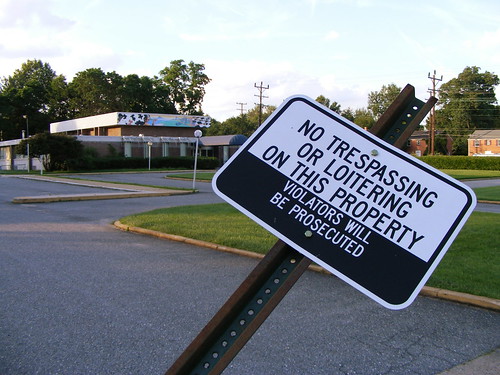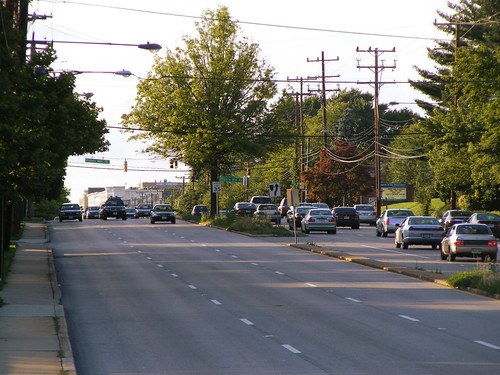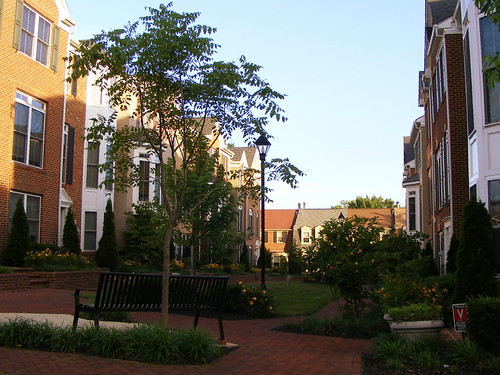
After a two-year fight to stop a housing development at the former Maryland College of Art and Design on Georgia Avenue, residents of the surrounding Carroll Knolls neighborhood are one step closer to having a much-desired park built on the land. Now all they have to do is win over the County Council - and find the money to get it done.
"I think we're on a good trajectory to turn this property into a park," says Councilmember Valerie Ervin, who attended a meeting with Carroll Knolls residents last Tuesday at the Capital View-Homewood recreation center in Kensington. Ervin, along with fellow councilmember Marc Elrich, discussed using county funding to purchase and build the park, at the intersection of Georgia and Evans Drive in Wheaton. Brenda Sandberg from the Department of Parks was also on hand to talk about the Legacy Open Space program, which would require support from the County Council and final approval from the Planning Board.
It's not that there's a shortage of parks near Carroll Knolls. Directly across the street from the former school is the Evans Parkway Park, which is funded for an expansion. But reaching the park would involve crossing Georgia Avenue, a main commuter route with heavy traffic throughout the day.

Activist Beverly Sobel, who's lived in a townhouse directly behind the former school for several years, says she's gone to Evans Parkway Park "like three times." She sits on the sustainability sub-committee in the Wheaton CBD redevelopment task force - and, as the daughter and granddaughter of home builders, understands the development potential of a site halfway between two Metro stations. But Sobel notes that while parks on the east side of Georgia are plentiful, the MCAD site is the "only green space" on the west side of the avenue between Glenmont and Downtown Silver Spring, a distance of four miles.
"It's not realistic for parents to ask their kids to cross Georgia Avenue to go to a park," says Elrich, who used to play in nearby McKenney Hills-Homewood Park as a kid. "It might as well be a wall." Nonetheless, he urged residents to "be open-minded" about what should happen to the land, noting that it would cost several million dollars for the county to acquire the land, demolish the school, and build a park there. One of the suggestions he offered was building a few houses to offset the cost of keeping the rest of the site open.
 For thirty years, the Maryland College of Art and Design was a source of pride for the community. Not only was it a place for residents to take affordable, enriching art classes, but its tiny campus was filled with student-produced public art. But in 2005, Montgomery College absorbed the school; two years later, when they moved it to a brand-new facility in Downtown Silver Spring, the building was vacated. Almost instantly, the site became a neighborhood blight, a haven for vandals and squatters.
For thirty years, the Maryland College of Art and Design was a source of pride for the community. Not only was it a place for residents to take affordable, enriching art classes, but its tiny campus was filled with student-produced public art. But in 2005, Montgomery College absorbed the school; two years later, when they moved it to a brand-new facility in Downtown Silver Spring, the building was vacated. Almost instantly, the site became a neighborhood blight, a haven for vandals and squatters.But what made residents of the adjacent Carroll Knolls neighborhood even more upset was the college's quiet transfer of the property to the Montgomery College Foundation, which raises money for the school. In 2006, the college made a sales agreement to Kaz Development, who proposed building twenty-seven townhomes on the site. A lawyer living in Carroll Knolls upheld the neighborhood's 1948 covenants, restricting use of the property to the twelve single-family homes it was originally zoned for. (Institutional uses like MCAD, and the Hebrew school which preceded it, are exceptions.) In response, the developer sued the civic association for preventing them to use the land as they wished.

"I take real issue with the idea that my money is going to Montgomery College - which I agree with - so that they can make income, says Carol Chace, who lives in Carroll Knolls. "For a taxpayer, that's really criminal."
Neighbors claim that the building has been repeatedly vandalized and occupied by squatters, and that Montgomery College has done little to maintain the site or assuage their concerns. (Representatives from the college promised to attend the meeting but did not show up.) The Montgomery County police department made an agreement with the college to use the vacant building for K-9 training, but stopped after one visit because of its dangerous condition.
Councilmember Elrich reminded the residents that the college, despite their negative actions, was still a public institution. "We have to separate the behavior from what the needs are," said Elrich. "This is not the case of some greedy corporation trying to fill their pockets."
Meanwhile, Councilmember Ervin pointed out that the school, which catered mainly to adult and youth classes, was a "losing proposition" for the college as attendance dropped. "We have to make sure people use these assets so we can keep them," she said.

4 comments:
I agree that the land should not be used for additional housing, however I don't feel the county should spend several million to build a park. Mrs. Sobel may be exaggerating when she said there are no green spaces on the west side of GA Ave between SS and Glenmont. There are actually several other wonderful parks in close proximity to Carroll Knolls neighboord (University and St. Paul, Plyers Mill, St Paul and Plyers Mill, just to name a few). Perhaps for now it would be sufficient if the college paid to demolish the building and allowed the open space to remain just that-an open space.
Hey Todd and Dan,
Sorry for any confusion.
Dan, I was referring to the Department of Parks' assessment of the area. Their staff noted "that there is no park property fronting the west side of Georgia Avenue from Glenmont down to the Silver Spring CBD, a distance of over 4 miles." Also, Parks noted "significantly fewer recreational opportunities on the west side of Georgia Avenue compared to the east side." Sorry for the confusion. I can send you the Legacy Open Space report on MCAD tonight if you are interested.
Thanks much Dan for writing about the MCAD story. We are hopeful of a positive outcome for all involved.
Regards,
Beverly
I wish I could say I was astonished by Montgomery College's approach to dealing with this situation, but as a cynic I have come to expect this sort of ploy.
"Look, we're failing to maintain a taxpayer-bought property. It's nothing but pure depreciation. Don't you think we owe better to the constituents?"
"Heck no! The faster it goes to hell, the faster we will hear mass complaints demanding that we get rid of it. Then we sell it off as a cost-free windfall for the endowment."
Um, but isn't it already part of the endowment?
Why yes, actually...
So who benefits?
It's a net loss to the endowment, but a huge gain to anyone looking to develop it.
As the director of finance for the Montgomery College Foundation, I wanted to clarify some of the information in your blog post.
The money spent by the Montgomery College Foundation is not taxpayer funds. The Foundation raises money to support Montgomery College students through scholarships and other initiatives. Maximizing the value of the former Maryland College of Art and Design (MCAD) property will help the Foundation continue to support students who could not otherwise afford a college education.
Montgomery College began managing MCAD and later merged because MCAD was losing hundreds of thousands of dollars a year and the county wanted to preserve the school's unique art program. The Foundation received the MCAD property as part of the merger.
The College and the Foundation continue to spend money on costs associated with the MCAD merger and the property, which includes maintenance. The former MCAD building was already in poor condition at the time of the merger. The school's art program moved to a new facility at the College's Takoma Park/Silver Spring Campus.
Knowing the community's concerns, the Foundation will work with the County Executive and County Council to facilitate a sale to the county or a designated agency, or remarket the property for development in accordance with the permitted land use.
Post a Comment